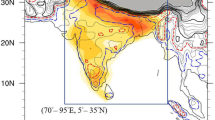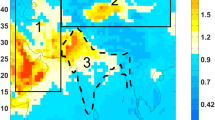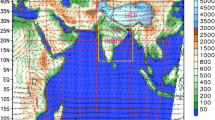Abstract
In this paper we present results of a numerical study using the NASA finite-volume GCM to elucidate a plausible mechanism for aerosol impact on the Asian summer monsoon involving interaction with physical processes over the Tibetan Plateau (TP). During the pre-monsoon season of March–April, dusts from the deserts of western China, Afghanistan/Pakistan, and the Middle East are transported into and stacked up against the northern and southern slopes of the TP. The absorption of solar radiation by dust heats up the elevated surface air over the slopes. On the southern slopes, the atmospheric heating is reinforced by black carbon from local emission. The heated air rises via dry convection, creating a positive temperature anomaly in the mid-to-upper troposphere over the TP relative to the region to the south. In May through early June in a manner akin to an “elevated heat pump”, the rising hot air forced by the increasing heating in the upper troposphere, draws in warm and moist air over the Indian subcontinent, setting the stage for the onset of the South Asia summer monsoon. Our results suggest that increased dust loading coupled with black carbon emission from local sources in northern India during late spring may lead to an advance of the rainy periods and subsequently an intensification of the Indian summer monsoon. The enhanced rainfall over India is associated with the development of an aerosol-induced large-scale sea level pressure anomaly pattern, which causes the East Asia (Mei-yu) rain belt to shift northwestward, suppressing rainfall over East Asia and the adjacent oceanic regions.








Similar content being viewed by others
References
Chang CP, Zhang YS, Li T (2000) Interannual and interdecadal variations of the East Asian summer monsoon and tropical SSTs. Part I: Role of the subtropical ridge. J Climate 13:4310–4325
Chin M, Ginoux P, Kinne S, Torres O, Holben BN, Duncan BN, Martin RV, Logan JA, Higurashi A, Nakajima T (2002) Tropospheric aerosol optical thickness from the GOCART model and comparisons with satellite and sun photometer measurements. J Atmos Sci 59:461–483
Chin M, Ginoux P, Lucchesi R, Huebert B, Weber R, Anderson T, Masonis S, Blomquist B, Bandy A, Thornton D (2003) A global aerosol model forecast for the ACE-Asia field experiment. J Geophys Res 108(D23):8654 DOI 10.1029/2003JD003642
Chou C (2003) Land-sea heating contrasts in an idealized Asian summer monsoon. Clim Dyn 21:11–25
Chou MD, Suarez M (1999) A solar radiation parameterization for atmospheric studies. Tech Rep NASA/TM-1999-104606, NASA/GSFC
Chou MD, Suarez M, Liang XZ, Yan MH (2001) A thermal infrared radiation parameterization for atmospheric studies. Tech Rep NASA/TM-2001-104606, NASA/GSFC
Hansen J, Sato M, Ruedy R, Lacis A, Oinas V (2000) Global warming in the twenty-first century: an alternative scenario. Proc Natl Acad Sci 97:9875–9880
Highwood EJ, Haywood J, Silverstone M, Newman S, Taylor J (2003) Radiative properties and direct effect of Saharan dust measured by the C-130 aircraft during SHADE-2: Terrestrial spectrum. J Geophys Res 108(D18):8578, DOI 10.1029/2002JD002552
Jacobson MZ (2001) Strong radiative heating due to the mixing state of black carbon in atmospheric aerosols. Nature 409:695–698
Kang IS, Jin K, Wang B, Lau KM, Shukla J, Krishnamurthy V, Schubert SD, Waliser DE, Stern WF, Kitoh A, Meehl GA, Kanamitsu M, Galin VY, Satyan V, Park CK, Liu Y (2002) Intercomparison of the climatological variations of Asian summer monsoon precipitation simulated by 10 GCMs. Clim Dyn 19:383–395
Kondratyev KY (1999) Climatic effects of aerosols and clouds. Praxis Publishing, UK, 264pp
Lau K-M, Kim K-M, Hsu C (2005) Observational evidence of effects of absorbing aerosols on seasonal-to-interannual anomalies of the Asian monsoon. CLIVAR Exch 10(3):7–9
Lau KM, Bua W (1998) Mechanisms of monsoon-Walker circulation: insights from GCM experiments. Clim Dyn 14:759–779
Lau KM, Li MT (1984) The monsoon of East Asia and its global associations—a survey. Bull Amer Meteor Soc 65:114–125
Li C, Yanai M (1996) The onset and interannual variability of the Asian summer monsoon in relation to land–sea thermal contrast. J Climate 9:358–375
Liu YM, Wu G (2004) Progress in the study on the formation of the summertime subtropical anticyclone. Adv Atmos Sci 21:422–342
Liu YM, Wu GX, Ren RC (2004) Relationship between the subtropical anticyclone and diabatic heating. J Climate 17:682–798l
Meehl GA (1994) Coupled land-ocean-atmosphere processes and South Asian monsoon variability. Science 266:263–267
Menon S, Hansen J, Nazarenko L, Luo Y (2002) Climate effects of black carbon aerosols in China and India. Science 297:2250–2253
Ramanathan V, Chung C, Kim D, Bettge T, Buja L, Kiehl JT, Washington WM, Fu Q, Sikka DR, Wild M (2005) Atmospheric brown clouds: impact on South Asian climate and hydrologic cycle. Proc Natl Acad Sci 102:5326–5333, DOI 10.1073/pnas.0500656102
Ramanathan V, Crutzen PJ, Kiehl TJ, Rosenfeld D (2001) Aerosols, climate and the hydrological cycle. Science 294:2119–2124
Sud YC, Walker GK (1999a) Microphysics of clouds with the relaxed Arakawa-Schubert scheme (McRAS). Part I: Design and evaluation with GATE phase III data. J Atmos Sci 56:3196–3220
Sud YC, Walker GK (1999b) Microphysics of clouds with the relaxed Arakawa-Schubert scheme (McRAS). Part II: Implementation and performance in GEOS II GCM. J Atmos Sci 56:3221–3240
Sud YC, Walker GK (2003) New upgrades to the microphysics and thermodynamics of clouds in McRAS: SCM and GCM evaluation of simulation biases in GEOS GCM. Proc Indian Natn Sci Acad 69(5):543–565
Wang B, Lin H (2002) Rainy season of the Asian-Pacific summer monsoon. J Climate 5:386–398
Wu GX, Liu YM (2003) Summertime quadruplet heating pattern in the subtropics and the associated atmospheric circulation. Geophys Res Let 30(5):1201
Wu GX, Zhang YS (1998) Tibetan Plateau forcing and the timing of the monsoon onset over South Asia and the South China Sea. Mon Wea Rev 126:913–927
Wu GX, Li WP, Guo H, Liu H (1997) Sensible heating-drive air pump of the Tibetan Plateau and the Asian summer monsoon. In: Ye DZ (ed) Memorial volume of Prof. JZ Zhao. Science Press, Beijing, pp 16–126
Yanai M, Li C, Song Z (1992) Seasonal heating of the Tibetan Plateau and its effects on the evolution of the Asian summer monsoon. J Meteor Soc Japan 70:189–221
Acknowledgements
This work is supported jointly by the Modelling, Analysis and Prediction (MAP) Program, and the Precipitation Measuring Mission (PMM) of the NASA Earth-Sun Exploration Division. M. K. Kim is supported by Climate Environment System Research Center (CES) sponsored by the Korea Science and Engineering Foundation. Part of the work was carried out by M. K. Kim during his visit to the Laboratory for Atmospheres, Goddard Space Flight Center under a Goddard Earth System Technology (GEST) visiting fellowship. The authors would like to acknowledge and thank Prof. G. Wu and an anonymous reviewer for their constructive comments and suggested revisions for this paper.
Author information
Authors and Affiliations
Corresponding author
Rights and permissions
About this article
Cite this article
Lau, K.M., Kim, M.K. & Kim, K.M. Asian summer monsoon anomalies induced by aerosol direct forcing: the role of the Tibetan Plateau. Clim Dyn 26, 855–864 (2006). https://doi.org/10.1007/s00382-006-0114-z
Received:
Accepted:
Published:
Issue Date:
DOI: https://doi.org/10.1007/s00382-006-0114-z




